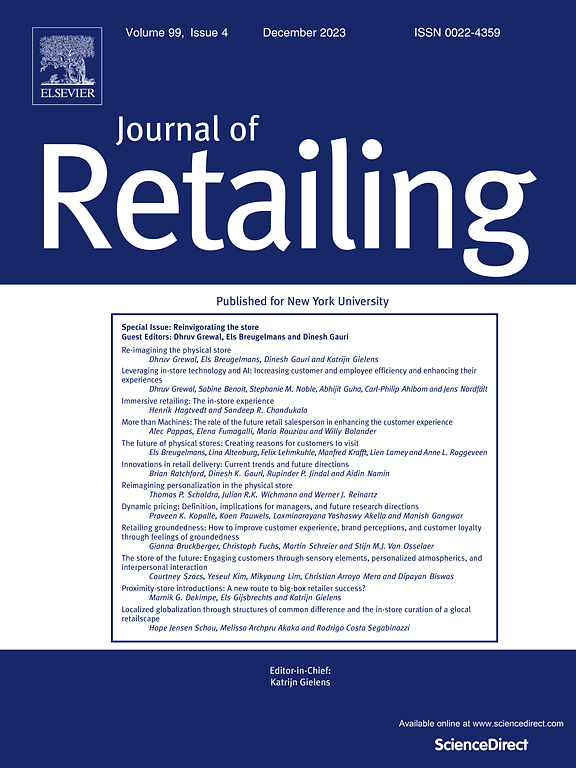Pricing cues and retail competition
IF 10.2
1区 管理学
Q1 BUSINESS
引用次数: 0
Abstract
Retailers that do not consistently display pricing cues (e.g., “Save $200″) may face lower demand from consumers who do not benefit from the additional transaction utility, a fact that is well-documented in the extant literature. This study investigates why some retailers choose not to display pricing cues despite these documented benefits, how optimal prices are affected by the display of pricing cues, and which type of retailer – service-focused or price-focused – is more likely to display pricing cues.
Analysis of our analytical model of competing retailers with asymmetric sales support reveals two effects of pricing-cue display: a “direct-demand effect” and a “competitive effect.” We find that when both retailers display a pricing cue, they can charge a higher price due to the increased transaction utility provided to customers (“direct-demand effect”). However, in the asymmetric scenario, when only one retailer displays a pricing cue, it has the additional effect of lowering the price of the non-displaying retailer (“competitive effect”). Further, we find that the price dispersion is higher when a service-focused retailer displays a pricing cue and the competing price-focused retailer does not, leading that case to be the more likely asymmetric equilibrium.
Empirical analysis of price and pricing-cue data for consumer-electronics products across several online retailers validates our analytical findings. Our analytical and empirical assessments underscore the significance of retailers’ pricing-cue display strategies and their impact on consumers, offering both academic and managerial implications.

价格线索和零售竞争
没有持续显示价格提示(例如,“节省200美元″”)的零售商可能会面临消费者的低需求,因为消费者没有从额外的交易效用中受益,这一事实在现有文献中得到了充分的证明。本研究调查了为什么有些零售商选择不显示价格线索,尽管有这些记录的好处,价格线索的显示是如何影响最优价格的,以及哪种类型的零售商——以服务为中心还是以价格为中心——更有可能显示价格线索。我们对具有不对称销售支持的竞争零售商的分析模型进行了分析,揭示了价格提示显示的两种效应:“直接需求效应”和“竞争效应”。我们发现,当两家零售商都显示定价提示时,由于提供给顾客的交易效用增加,他们可以收取更高的价格(“直接需求效应”)。然而,在不对称场景中,当只有一个零售商显示价格提示时,它具有降低非显示零售商价格的额外效果(“竞争效应”)。此外,我们发现,当以服务为中心的零售商显示价格线索而竞争的以价格为中心的零售商不显示价格线索时,价格差异更大,导致这种情况更有可能成为不对称均衡。对几个在线零售商消费电子产品的价格和定价线索数据的实证分析验证了我们的分析结果。我们的分析和实证评估强调了零售商的价格提示展示策略的重要性及其对消费者的影响,提供了学术和管理上的启示。
本文章由计算机程序翻译,如有差异,请以英文原文为准。
求助全文
约1分钟内获得全文
求助全文
来源期刊

Journal of Retailing
BUSINESS-
CiteScore
15.90
自引率
6.00%
发文量
54
审稿时长
67 days
期刊介绍:
The focus of The Journal of Retailing is to advance knowledge and its practical application in the field of retailing. This includes various aspects such as retail management, evolution, and current theories. The journal covers both products and services in retail, supply chains and distribution channels that serve retailers, relationships between retailers and supply chain members, and direct marketing as well as emerging electronic markets for households. Articles published in the journal may take an economic or behavioral approach, but all are based on rigorous analysis and a deep understanding of relevant theories and existing literature. Empirical research follows the scientific method, employing modern sampling procedures and statistical analysis.
 求助内容:
求助内容: 应助结果提醒方式:
应助结果提醒方式:


